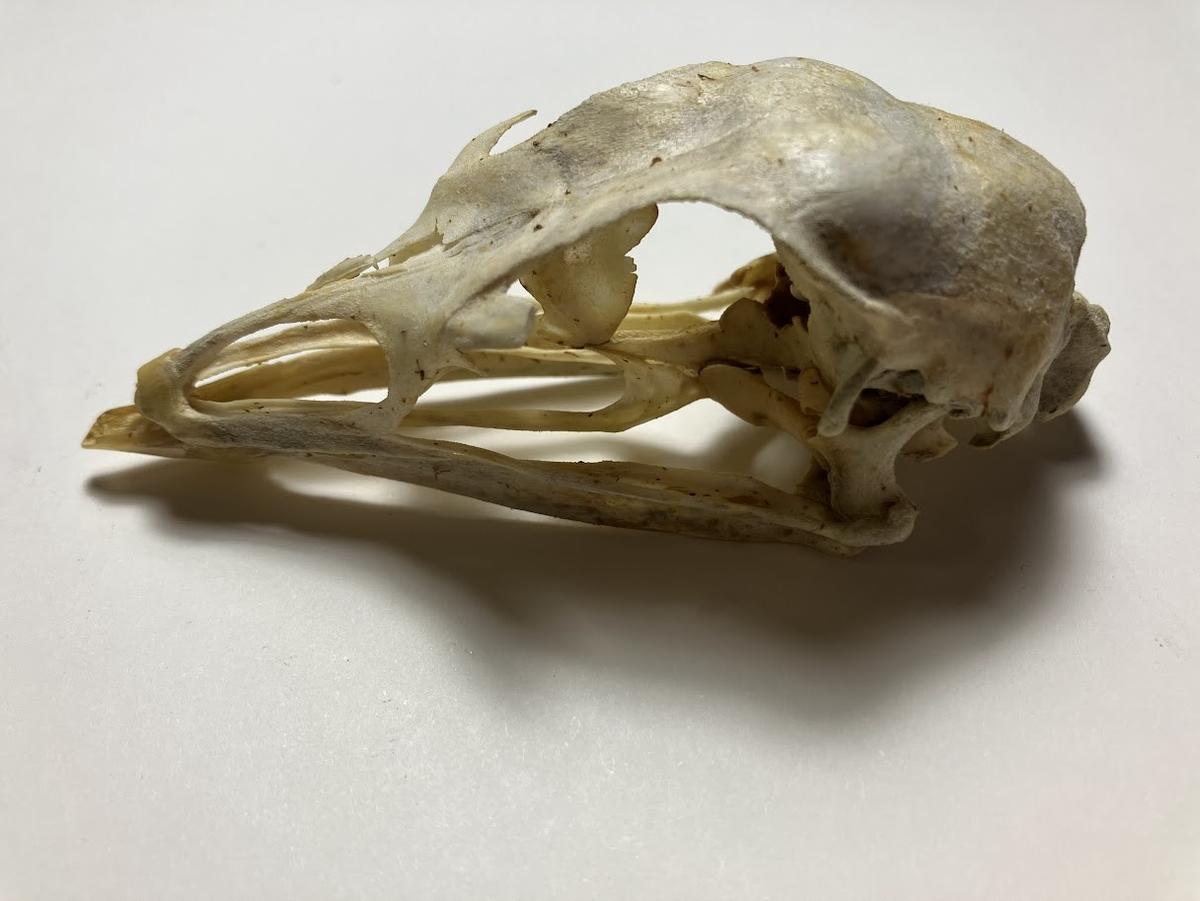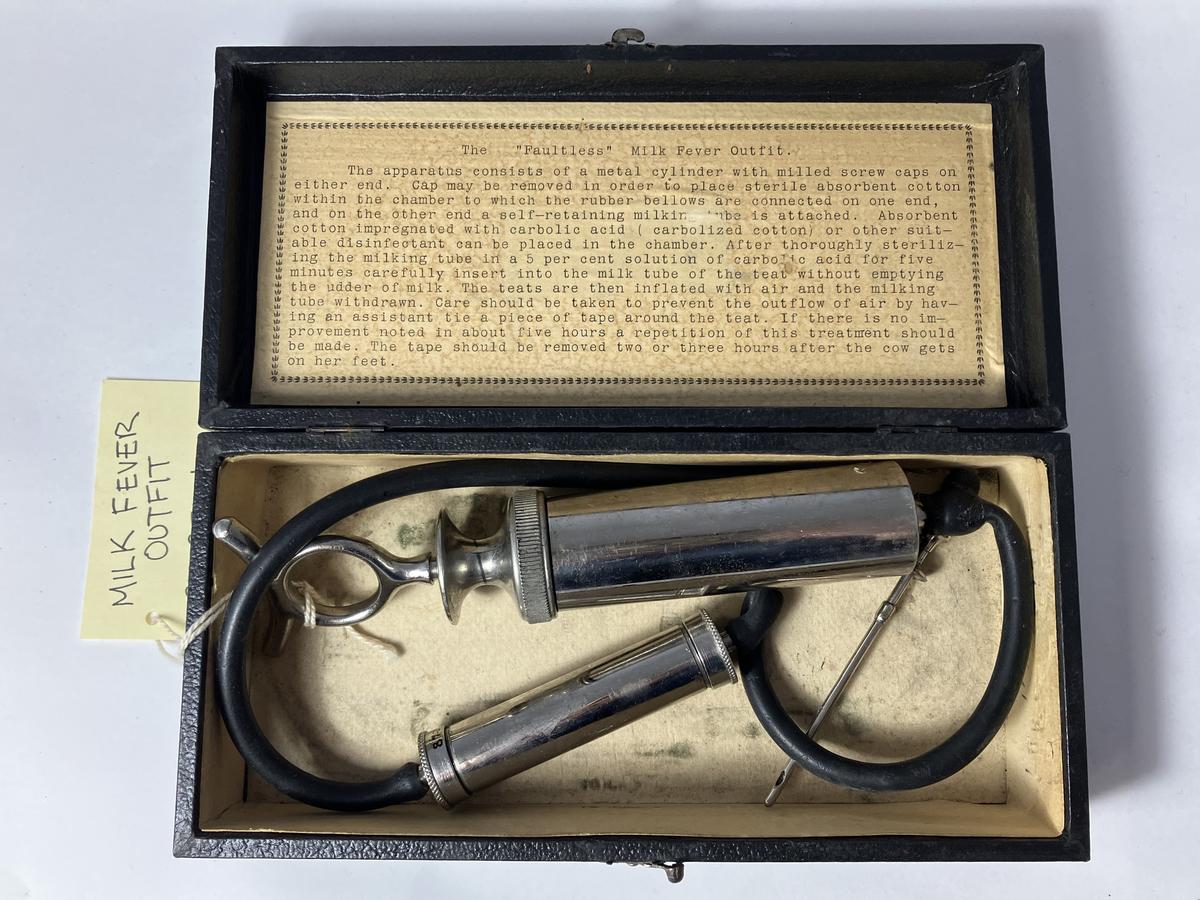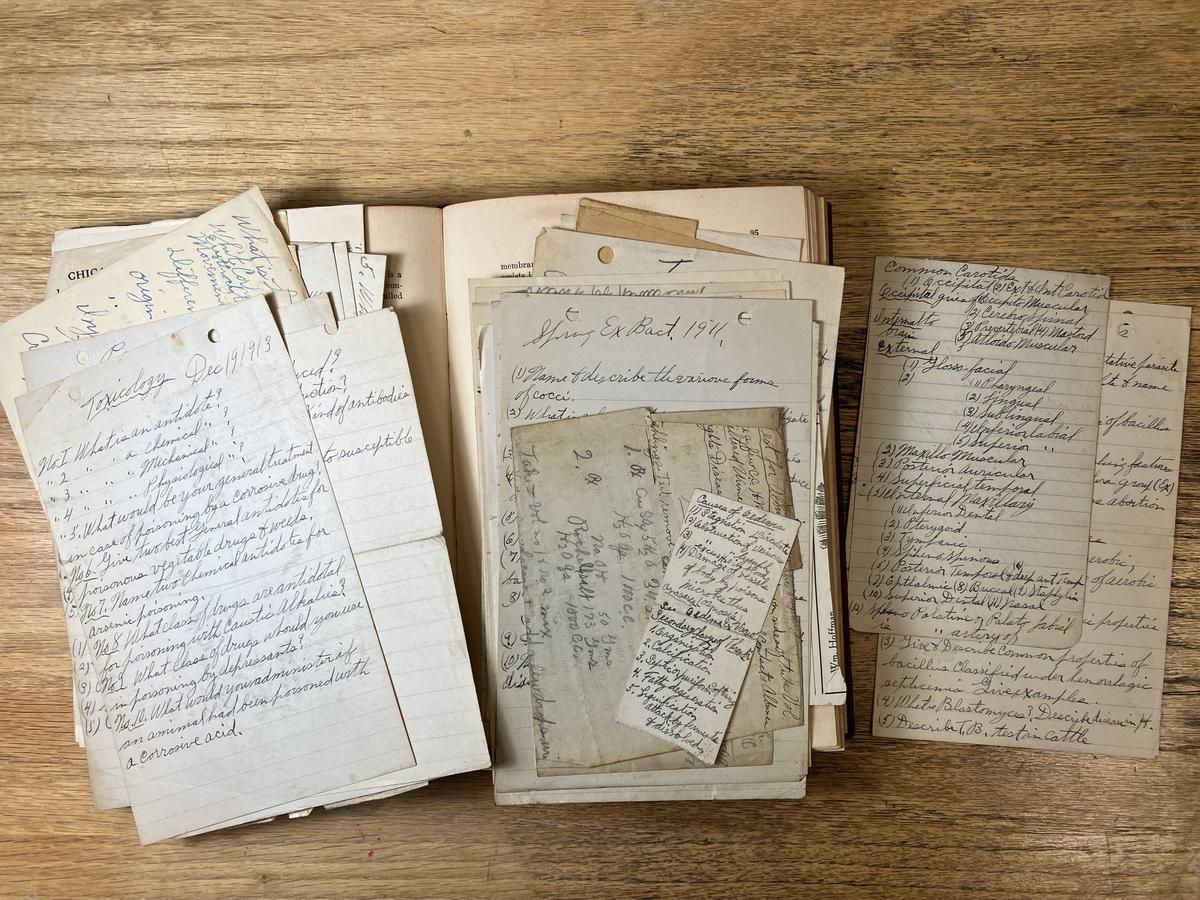Our museum collects all history of veterinary medicine, emphasizing local history-makers in Minnesota. Our collection includes veterinary instruments, pharmaceuticals, furniture, lab equipment, notebooks, pharmaceutical formularies, books, photographs, publications, and anatomical prints.
We have over 6,000 catalogued objects and 1,000 photos. We have a collection of over 900 veterinary books published between 1680 and the present.
We have several collections of archival material, mainly from the 20th century, from faculty, researchers, and local veterinarians.
Research
Select Archival Series
Affiliated Emergency Veterinary Service
1978-79; 2017. One three-ring notebook, two booklets. Acquired from Ed Clausman in 2017.
Records of an emergency veterinary service that began in St. Louis Park in 1978 and grew to include seven clinics by 2017.
Three-ring notebook, 1978-79.
Contains documents and meeting minutes relating to the foundation of AEVS in 1978. The organization was formed when Drs. Ed Clausman, Bill Funk, Gene Porter, and David Spong brought interested colleagues together. An emergency clinic had been operating from a practice in the Southdale area during the previous year, and AEV planned to expand the concept and involve practitioners from a wide area. On July 27, 1978, twenty-five veterinarians met at the home of Dr. Funk, and by mid-August, twenty-one clinics had committed $25 each to make a start. Nearly all of them had practices in the south or west metropolitan suburbs. A location near Highways 12 and 100 was preferred for the AEVS clinic site, but plans were hindered by zoning restrictions. A building was eventually leased at 5305 Cedar Lake Road in St. Louis Park. The clinic opened sometime after May 7, 1979. AEVS was incorporated in early February, 1979, and adopted bylaws in June. A plan for the interior of the clinic, and an undated policy document are included. The policy document describes fees, policies for payment, and such things as how to treat animals brought in by the police or other authorities. It includes the statement: “no animal will be not given emergency care because of the owner’s inability to pay.”
Booklet, “Affiliated Emergency Veterinary Service,” no date, c. 2017.
Chiefly photos of clinics in Golden Valley, Rochester, Duluth, St. Cloud, Blaine, Coon Rapids, Eden Prairie. Includes corporate organizational chart and mission statement. 6 pages, 8.5 x 11 inches.
Booklet, “A Brief History of AEVS, as Remembered by Ed Clausman, D.V.M., Terry Rapacz D.V.M., Dick Olson, D.V.M.” 2017.
Includes a list of charter members. 6 pages, 8.5 x 11 inches.
Architectural Plans for U of M Veterinary Buildings, undated
Obtained from the College of Veterinary Medicine, from the collection of Prof. Carl Osborne.
Measurements, in inches, are approximate. Blue print plans:
- Lewis Hospital for Companion Animals, Building 427, Level 2 (one sheet, 36 x 24)
- Lewis Hospital for Companion Animals, Building 427, Level 4 (one sheet, 36 x 24)
- Veterinary Complex (Building 371, Veterinary Medicine Building; Building 374, Veterinary Science Building; Building 385, Veterinary Medicine Diagnostic and Research Lab):
- Veterinary Complex First floor (one sheet, 45 x 36)
- Veterinary Complex Second floor (one sheet, 45 x 36 )\Veterinary Complex Fourth and Fifth floors (one sheet, 45 x 36).
Busch, John Edward DVM, 1917 – 2010, papers
A small collection of papers and photographs relating to the training and practice of John Busch. Originally from the vicinity of Morris, Minn., he was a member of the U. of M. Vet. School’s first class, which graduated in 1951. He practiced in Chokio, Minn. The museum also owns a collection of books from Dr. Busch, including the textbooks used for his veterinary training.
Veterinary school
Items in this group reveal the rapid pace of events when Busch submitted his application to the veterinary school in 1949 as the Department of Agriculture at the University of Minnesota worked to prepare for the first class. A letter of acceptance is dated August 18, 1949; a receipt for a $10 deposit on tuition is dated August 30. The letter instructs Busch to register for classes sometime after August 25. Includes a diploma for a U. of M. baccalaureate degree (June 1949); a receipt from the veterinary licensing board (May 26, 1951); a license to practice (June 1951); and a diploma for his DVM degree (June 19, 1951). An undated clipping from the St. Paul Pioneer Press is titled “Veterinary Hospital Needs Told.”
Practice
The collection includes a few billhead blanks, recipe cards for formulations, and pharmaceutical label blanks. A folded newspaper section from the Chokio Review of June 28, 1951, contains a front page article welcoming Dr. Busch to town. An editorial from an unknown paper describes Dr. Busch’s work to fix an injured bird for three neighborhood children.
Personal
Included is an invitation to a 1949 U of M commencement event addressed to Helen Bjerkness.
Photographs
A pair of slides show a completed C-section on a cow, and a pair of conjoined bovine twins. Other significant photos are: a formal portrait of Dr. Busch; some scenes from his veterinary training; a 1948 veterinary-themed parade float; several photographs of family gathering to celebrate Dr. Busch’s graduation; a group photo of the class of 1951 vet students in front of the U of M veterinary clinic; a formal class photo showing the class of 1951. Photographs from this acquisition have been transferred to the museum’s photograph collection.
Provenance
Received from the family of Dr. Busch; catalogued by Paul Maravelas in 2018.
Catalog of Oral History Interviews, 1984 - 2004
The following sound recordings of oral history interviews were created under the auspices of the Minnesota Veterinary Historical Museum. A few recordings of other activities are included, including class lectures, a panel discussion, a memorial service, a graduation address, a groundbreaking ceremony, and a ride in a Model T car.
Originally recorded on magnetic tape, this material was converted to the CDA digital format and transferred to 83 compact disks in 2007. They emerged from Dr. Carl Osborne’s office at the College of Veterinary Medicine after his death in 2017. The collection was cataloged in August, 2017 by intern Maxine Lightfoot and curator Paul Maravelas.
Hanlon, Bee, DVM (1923-2010), papers
Griselda (Bee) Wolf Hanlon graduated from the University of Minnesota College of Veterinary Medicine in 1952, joined the faculty, and retired in 1985.
Contents:
Photograph: “X raying a Horse, Oct. 1898.”
Black and white photograph, 8 x 10 inches, showing a supine horse with legs bound, four men, and an x-ray machine on a cart. This appears to be a modern reprint of an 1898 photo. Marked on reverse: “Donated to Museum. G.F. Hanlon was given the photo from Mr. Williams ̶ Cambridge, England on my quarter leave in 1972.”
Offprints of four professional papers in radiology, 1969 to 1982, including two published in The Journal of the American Veterinary Medical Association.
Includes a complete copy of the February 1978 issue of the Journal of the Japanese Veterinary Radiology Society, with an enclosed letter from the secretary of the society, Tesshu Matsubara, apologizing for publishing one of Hanlon’s articles without permission. “Ignorantly, I did not know about copyright . . .” Dr. Matsubara wrote.
Mimeographed paper, “Outline of Roentgen Methods and Interpretation of the Urinary System of the Dog and Cat,” by Griselda F. Hanlon, no date, College of Veterinary Medicine, University of Minnesota, 29 pages.
Papers related to the proposed closing of the College of Veterinary Medicine
File folder marked “CVM Veterinary Medical Council, July 15, 1987,” which includes items relating to the University’s proposal to close the College, and the College’s efforts to counter the plan. Contains a dozen memos, including a letter from Dr. Barb O’Leary, president of the Minnesota Veterinary Medical Council, calling for a special meeting on July 15, 1987.
Master’s thesis, University of Minnesota, 1955
A bound copy of Hanlon’s master’s thesis, “A Study in the Bacteriology and Therapeutics of Canine Otitis Externa.”
Acquired by the museum from the estate of Bee Hanlon in May, 2018. Cataloged by Paul Maravelas in August 2018.
Glenn Nelson papers
A small collection of papers and photos belonging to Dr. Glenn Nelson (1921-2010), all related to veterinary events. Dr. Nelson is credited with encouraging University administrators and legislators to establish the U. of M. School of Veterinary Medicine, from which he graduated in 1951. After practicing large animal medicine in New Richland, Minn., for about ten years he returned to St. Paul in 1961 to work at the Veterinary Diagnostic Lab. He retired in 1992.
Contents
Certificates, 1967 – 1986
Certificates awarded to Nelson, and a letter of resolution, from: Association of Am. State Board of Examiners in Veterinary Medicine, 1967; Am. Academy of Veterinary and Comparative Toxicology, 1983; Minnesota Board of Veterinary Medicine Examiners, 1986.
Letter March 1, 1972, from Professor Clyde Christensen, Dep. of Plant Pathology, to Professor John Higbee, Col. of Vet. Med., describing Dr. Nelson’s research in mycotoxins and estrogenism in swine (photocopy).
Eagle Release, 1991
Letter, certificate, and photos relating to the release of an eagle from Fort Snelling by the U of M’s Raptor Center and Dr. Nelson on November 11, 1991.
Veterinary Medicine Newsletter [U. of Minn. College of Vet. Med.] Clippings, 1987-1997.
Four clippings, all involving Nelson as a subject or informant.
Veterinary Diagnostic Lab groundbreaking, St. Paul Campus, June 6, 1991
Printed program from the groundbreaking event, and a series of photographs, apparently taken by a professional photographer. Dr. Nelson participated in the groundbreaking ceremonies.
Photographs
Photographs from this acquisition, including those mentioned above, have been transferred to the museum’s photograph collection. These include color and black and white photos of various people and events, including: Class of 1951 veterinary students posed near the entrance to the U of M veterinary clinic; participants in a dedication ceremony for a Remington sculpture given by the U of M small animal hospital, and an informal photo of Nelson with James H. Steele DVM, Deputy Assistant Secretary for Health and Human Services and “the father of veterinary public health.”
Other incidental papers are included in this collection as well.
Provernance
Cataloged by Paul Maravelas. Biographical info on Dr. Nelson is taken from a 2007 interview by Linda Cameron of the Minnesota Historical Society, and from Dr. Nelson’s obituary published in the StarTribune.
Peter Poss, DVM: Client Bills and Invoices for Supplies, 1963-65
Records of work done for clients when Dr. Poss practiced in Litchfield, Minnesota. The records are hand-written on pre-printed forms and show the name of the farmer or client, a brief description of the service or product, the amount charged, cash balances, and payments. The collection also contains a file of invoices dating from 1963-4 for supplies purchased by Dr. Poss. Among these are invoices from several Minnesota concerns, including: Diamond Laboratories Sales Corp. of Mankato; Mille Lacs Veterinary Supply of Princeton; Midwest Veterinary Supply of Minneapolis and Moorhead; and the Hallquist Veterinary Sales Co. of Litchfield.
Holdings: 1963-65. One box.
Given to the museum by Dr. Peter Poss, October 1, 2016.
Cataloged by Paul Maravelas.
Student Notebooks (1911-1920)
A collection of bound manuscript class notes
Written by veterinary students George A. Larson Jr., Chicago Veterinary College; Walter Lindquist, Chicago Veterinary College; Alfred Ostendorf, McKillip Veterinary College; Nels A. Runquist, Chicago Veterinary College; and Ralph L. West, Kansas City Veterinary College. This collection includes:
Larson’s notes on Pharmaceuticals (1920) and Physiology (1914).
Lindquist’s notes on Types and Breeds of Farm Animals (1915), and Anatomy (c. 1912).
The latter contains extensive sketches of anatomical material, some in color, and a personal rent receipt from 1934.
Osterndorf’s notes on Maladies and Recipes
This collection includes notes on: regulations for animal health from a lecture by U. of M. professor Malcolm Reynolds; anatomy (two notebooks); “Clinic,” Canine Diseases and Medicine, Pathology, Equine Medicine, Chemistry Laboratory, Bacteriology Laboratory, and Pharmacology. (c. 1911-1913)
Runquist’s notes and corresponding drawings on Anatomy and Biology (no date).
West’s notes and corresponding drawings on Pathology (1916).
Suburban Veterinary Medical Association
Financial records, minutes, meeting notices, bylaws, correspondence, and member lists, 1960-2012.
Formed in 1958, the Suburban Veterinary Medical Association was a professional organization that served veterinarians west of Minneapolis. Its records list members from a wide area, ranging from Minneapolis to Cold Spring, Belle Plaine, and Rosemount. It disbanded in early 2015.
The collection includes 1965 correspondence on disciplinary action regarding Dr. Robert Dingel; a 1968 list of speakers available from the U. of M.; and the results of a 1998 survey of association members that describes their motivation for joining the group and their preferences for meeting schedules and subjects. A highlight of the collection is a printed sheet issued in 1959 titled “Suggested Schedule of Minimum Fees for Suburban Veterinary Medical Association.”
The collection was acquired by the Minnesota Veterinary Historical Museum in 2015 from Dr. Joni Scheftel, the Suburban Veterinary Medical Association's former treasurer.
Cataloged by Paul Maravelas
CVM Tuition, 1948-1984, Univ. of Minnesota
Resident and non-resident tuition rates for students enrolled in the professional veterinary program are given in the document below. The rise in tuition rates was primarily affected by chronically decreasing financial support from the State Legislature, while the cost of the professional teaching program increased. As a rule, the percentage of state support in the College budget has continually decreased over time.
The figures here were extracted from College bulletins published biennially and from information maintained in college administrative offices.
West Central Minnesota Veterinary Medical Association records
Contains: minutes, meeting notices, printed constitution and bylaws, correspondence, 1958-1968.
The West Central Veterinary Medical Association was a professional organization that served veterinarians in West Central Minnesota. The organization met in various towns including: Willmar, Spicer, Montevideo, Morris, Benson, Dawson, Sauk Center, and Paynesville.
The collection includes notes and correspondence written on the letterhead of veterinarians and clinics in several towns in West Central Minnesota, including: Alexandria, Willmar, Kerkhoven, and Wheaton. Most of the correspondence involves invitations to prospective speakers.
Also included is a printed sheet issued in 1960 titled “Minimum Fee Schedule CMVA” which lists costs for various procedures. The fees listed are proposed, and were meant to be discussed at a future meeting of the association.
Three printed copies of the organization’s constitution and bylaws, dated 1958, are included.
Given to the Minnesota Veterinary Historical Museum in October, 2016 by Dr. Peter Poss, former secretary of the West Central Veterinary Medical Association.
Cataloged by Paul Maravelas.
Willmar Veterinary Clinic Financial Records
1953 – 1969
Gerry Peterson DVM, U of M class of 1953, started his practice in Kerkoven, then moved the practice to Willmar in about 1958. Dr. Olson joined the practice in 1960. Dr. Peterson left the practice in 1963. The practice stopped using ledger books in 1969. Dr. Olson left the practice in March 1976.
(History provided by Dr. Olson in November, 2015.)
Zollman, Paul E., DVM, 1921-2008. Papers
Dr. Paul Zollman was born Dec. 3, 1921 in Macon, Missouri, and graduated from the University of Missouri Veterinary school. He was head of veterinary medicine at the Mayo Clinic's Institute Hills Farm research center. He worked for 41 years at the Mayo Clinic and was the Minnesota Veterinary Medical Association Veterinarian of the Year in 1990. He died on October 29, 2008.
Dr. Zollman was instrumental in the development of Rochester's Oxbow Park and the Zollman Zoo, which was named in his honor. A conference room at the Mayo Clinic was named in his honor in 2012. He was a member of many civic organizations, including the Izaak Walton League, of which he was state president in 1962; the Minnesota Zoo Board and Oxbow Park Board; the Rochester Planning and Zoning Commission; and the Olmsted County Fair Board. He also taught firearm safety with the DNR for 45 years.
One file.
Seven pages of records relating to dogs, presumably dogs kept for Mayo Clinic experimental work, one labeled “Medication -- Dogs (New) Oxytetracycline” (1963); and six labeled: “Mortality of New Dogs,” (1952-1993).
Five undated and unlabeled photographs showing cages and buildings, presumably for Mayo Clinic animals. The photo mounts are marked with Mayo Clinic tags and numbers.
Minnesota Zoo Slides
A collection of 1,011 slides from the Minnesota Zoo, including historic procedures, animals, and research efforts. Slides range from 1978 to the early 2000s.
Collection includes but is not limited to:
Asian Wild Horse Procedures (1979)
Wolverine Dental Procedure (1982)
Ulysses S. Seal Amur Tiger Research (1982 - 1985)
Tapir Ultrasound (1989)
Plushie Removal from Doni the Komodo Dragon (2001)




